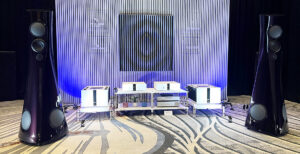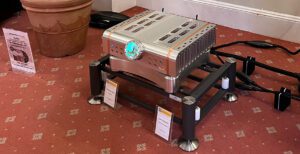
After a two-year absence, Munich High-End has finally returned, complete with a new brand ambassador in studio legend Alan Parsons. What has become the largest and most important show on the audio enthusiast calendar is back at last, at the MOC exhibition centre to the north of the Bavarian city. Before the enforced break, Munich High-End was the largest show of its kind, with hundreds of exhibitors taking all four halls, two atria, and the dozens of glass-fronted demonstration rooms on the two upper flights of Atrium 4. Despite soaring temperatures in those glass-fronted rooms (with outside temperatures reaching 34°C/93.4°F at times, sitting in a room filled with hot-running audio electronics and sweltering audio enthusiasts was often ‘challenging’), the weekend public days were packed, and people are clearly keen to be back!
In total, the show organisers registered 19,767 visitors across the four days, comprising 9,472 trade visitors from 80 countries, 9,878 consumers from 69 countries, and 417 media representatives from 36 countries. These visitors encountered 450 manufacturers with 800 brands from 40 countries. These figures compare favourably with the numbers from 2019.
However, the 2022 world is different and the show reflected that change. recent and significant supply chain issues meant many products expected to be ‘on demonstration’ at Munich were ‘on show’ or even ‘coming soon’, with either an empty box prototype or even little more than a computer graphic. A handful of companies even decided not to exhibit despite booking an expensive booth because they were beset by shipping problems, supply chain problems, and manufacturing problems due to COVID-19 putting members of their workforce out of action in the run-up to the show.
In addition, while the COVID-19 pandemic is decreasing in force worldwide, many Asia-Pacific countries are still imposing lengthy quarantines on travellers, and it seems few are willing to spend weeks in self-imposed isolation for a couple of days in Germany. Factor in the absence of visitors, manufacturers, distributors and press unable to attend due to the Ukrainian conflict, and many Americans chose AXPONA 22 as their lone Spring 22 expo, and the show felt quieter during its two trade days.
To make the show more actively ‘business’ the two trade days included the new IPS (International Parts + Supply) event, which allowed OEM trade manufacturers to ply their wares to audio companies. This is a good idea because few members of the public are particularly interested in talking about PCB stand-offs or having conversations with the manufacturer of feet for amplifiers, but such conversations are a gift to audio makers. The show also featured a ‘start-ups’ section and the lower halls were, as ever, broadly divided into zones (headphones, vinyl, etc).
This year, perhaps understandably, the usual moments of wild excess were few and far between, there were a few cars on display at the show (perhaps most notably, Dynaudio’s own display… of a pristine condition DeLorean), but none had been crane-lifted onto one of the atriums. This was also not a show to spot trends in audio, although in very broad terms this was the show where wireless loudspeaker streaming became more accepted even in audiophile circles. But new products were still abundant.
Here’s our list of some of the best new products we saw at Munich High-End 2022. Such a list is never going to be exhaustive, as even a top 200 would be cutting a lot away:
Aavik Acoustics

The latest integrated amp from the already distinctly high-end Aavik brand goes for the stratospheric. It features 200W of surprisingly cool-running Class A power, thanks to an innovative high current driver stage. The industrial design of audio legend Flemming Rasmussen to bring some gravitas to the look and feel of amp, too. Alongside the I-880, the group presented Børresen’s new M1 loudspeaker that takes the iron-free magnet technology to new levels, and new Gold Signature cables from Ansuz. This all represents a new high point for the brands… with anticipated prices to match!
Ambitious Audio Design

Shown in several forms across the years at Munich, Ambitious’ A1.1 two-way stand-mount more than lives up to the name, with every aspect of loudspeaker technology – from the construction of a cabinet to the Linear Lossless Suspension drive units are all designed like no other, using extensive amounts of aluminium and carbon fibre in unique, cabinet-eliminating designs. The two way is designed to work with a subwoofer (an Ambitious Audio Design sub in early prototype form was also on show). The A-Series loudspeaker is in its last phases of pre-release development. The price is Ambitious too… at €95,000 per pair.
Audiobyte

Still in early prototype form, Audiobyte’s excellent trio of streaming transport, DAC, and power supply are proving popular among headphone enthusiasts and audiophiles alike, but the Romanian brand showed its work-in-progress Super trio, that improve on each aspect of the existing trio, including better DAC, improved firmware and the addition of balanced headphone output. These products will likely make it to market sometime in 2023, but you heard it here first!
AudioQuest

One of the most poised-sounding high-end systems at the show, the combination of dCS Rossini Apex digital front-end, Einstein Audio The Preamp and Integrated amplifiers, Wilson Audio Sasha DAW loudspeakers and AudioQuest’s Niagara 7000 power conditioner and the company’s excellent new Mythical Creatures cable line. Where some systems emphasised a forward or bright sound and others overcompensated with too dark or laid-back a presentation, this one really hit the Goldilocks spot.
Audio Research

The new flagship power amplifier from Minnesota’s amp experts is scheduled to arrive later this year and its price is still to be confirmed, but the 320W balanced and single-ended input KT150-powered mono power amp is expected to be a real superstar, especially as it takes advantage of Audio Research’s new in-house finishing. This allows a greater range of colours first seen in the company’s I/50 integrated amplifier.
Audiovector

At 40kg a piece, and with a pair 200mm in the bass and an AMT driver in the treble, the new QR7 from Audiovector looked and sounded like one of those fine tower loudspeakers in the €10,000-€20,000 price range. Except it costs €5,700/£4,995. This was one of the stars of the show, delivering a sound with punch and refinement in equal measure and really filling a room, both with music and listeners, despite being in one of the pressure cookers of the baking hot top floor of the Munich MOC.
Boulder

The latest design from the Colorado-based high-enders, the $8,850 Boulder 812 DAC Preamplifier is a high-performance headphone amplifier, but one that can its balanced and single-ended personal audio connections behind a magnetic plate for those who simply want a digital converter or digital preamp. Styled to match the 880 integrated amplifier, this is a perfect stand-alone device for high-end headphone users.
Burmester

Unlike many companies in the audio business, Burmester doesn’t change its products too often. This means the company saying a fond farewell to one of its range is a big thing – especially when the farewell is to the evergreen 911 power amplifier, now in Mk 3 form but still based on the circuit from 1991. The replacement isn’t one power amplifier, but two, the 216 for the company’s Top Line and 218 from the Reference Line; both based on a new circuit design drawn from the current Signature Line 159 flagship mono amps. Both can be used in stereo and mono form with the 218 (shown) selling for €35,000. These are said to deliver 909 or 159-grade performance but in a chassis closer to the 911 Mk 3.
Chord Electronics

At the last Munich Show, Chord Electronics surprised everyone by announcing its first wholly new range of power amplifiers in years… the Ultima series. This year, the new £6,000 Ultima Pre 3 analogue preamplifier joins the line. The five balanced/three single-ended design has individually buffered and selectively filtered inputs and a brightly-lit central sphere aesthetic that matches well with the company’s digital designs and the Ultima range of power amps.
Dan D’Agostino Master Audio Systems

If Dan D’Agostino’s Relentless mono power amps weren’t beefy enough for you, the new Relentless Epic update delivers an input stage with devices that deliver a 300% increase in current and a new bias stability circuit that produces almost 50% increase in operating bias. The Epic costs $349,500 per pair and existing owners can upgrade to Epic status for $49,500 per pair. Meanwhile, those wanting Relentless performance but don’t need its 1.5kW power can opt for the new Relentless Epic 800. Housed in the same chassis and using the same basic circuit (but with fewer output transformers), the 800W per channel Epic 800 is priced at $194,500 per pair.
dCS

Arguably, dCS invented the Schrödinger’s Product Launch… in all the right ways. Technically, there was nothing new at the show in terms of outright product (in fact, the company introduced Lina, a wholly new headphone amplifier system… but did so a day after Munich). However, Munich was one of the first public outings of the company’s new APEX upgrades to the Vivaldi and Rossini product lines, which is the biggest change to dCS technology in years, as it fundamentally reworks the Ring DAC at the core of dCS digital platforms. So significant, in fact, that dCS revived the strictly limited four-into-one box Vivaldi One APEX player for the launch.
DeVore Fidelity

It seems that John DeVore doesn’t know how to make a bad loudspeaker. His high-efficiency, wide-baffle two-way stand-mount Orangutan line of loudspeakers are commonly considered to be some of the nicest sounding models around, but many companies struggle when making a bigger or smaller version of their biggest hit. However, in producing the new O/baby – essentially a smaller version of the popular O/96 with a horn-loaded 1.9cm dome tweeter and 178mm paper cone – DeVore made a loudspeaker that retains that O/96 magic but at $5,750 per pair comes in at less than half the cost.
Dynaudio

OK, so much of the ‘focus’ on Dynaudio was on the pristine Dynaudio-equipped DeLorean parked in the foyer of the show, but in the real world, Dynaudio launched its new high-end wireless Focus trio of products. The €5,000 Focus 10 two-way stand-mount, €7,500 Focus 20 and €10,000 Focus 30 floorstanders all feature extensive wireless audio capabilities alongside their active powered performance.

This was the first press launch of the event and the expectation was that many other companies might follow where Dynaudio (and KEF with its new LS60) are leading. But so far, these two are the trailblazers.
EAT

In German, the name means ‘C Major’ and is pronounced ‘Seder’ (like the Passover ritual). However, EAT’s new C-Dur sits midway between the existing C-Major and C-Sharp turntables, and retains the record clamp and gimballed C-Note arm of the other products in the C range. Priced at $3,595 in satin black and $4,295 in high-gloss plum the integrated player can be supplied with the Jo No5 cartridge. EAT also launched two versions of the 12” F-Note tonearm (now in Mk 2 guise); the Variable Tube and Variable Headshell versions, in both black (for $3,295) or polished aluminium (for $4,395).
Ensemble Audio

Stepping away from the main show for a while, Ensemble Audio of Switzerland holds a one-man-band event at the Pullman Hotel near the off-site Hi-Fi Deluxe Show. While the products ostensibly remain the same, internally they are subject to a series of listening-test derived revisions over the years. So, the Massimo Fuoco, Massimo Fonobrio and Ondiva loudspeakers (now in Gold form) produce an extremely elegant and musical sound, that is especially capable with extremely complex classical music.
Epos Acoustics

Recently, the classic Epos brand changed hands once more, moving from being under the auspices of Creek Audio to being owned by Karl-Heinz Fink of Fink Team. The first model from the reborn brand harks back to the company’s original roots; the ES14N is named after the popular ES14 of the late 1980s. The two-way, rear-ported stand-mount carries little more than the name over from the past, however, and this double-layered asymmetric cabinet stand-mount is every inch a Fink model and is expected to cost around €4,500 when launched later in the year.
Fyne Audio

Having built a commanding reputation (and a major back-order list) for its five current ranges of products in the hi-fi world, Fyne Audio announced its Vintage and Vintage Classic lines. These use a distinctly retro styling coupled with some very up-to-date technology used in Fyne’s most popular designs. The curved Vintage line uses real wood throughout with cryo-treated crossovers and a unique Presence control dial to tune the sound to the room, while the more squared off Vintage Classic wraps MDF in real-wood veneers, but still allows some modification of the crossover limits. The range was expanding faster than the company could produce its literature, but the Vintage Twelve playing sounded lovely. Prices are still to be confirmed but are expected to start at around £4,000 and reach up to £30,000.
Funk Firm

Having shown off a monumental and innovative deck-meets-stand at the last Munich show, Funk Firm’s static display this year was a little less outré, but no less innovative. The company’s Kepler turntable uses a vacuum hold-down platter, gives the listener the option of switching between belt and direct drive, and has provision for three rotating arms in orbit around the deck (hence the Kepler name). The Raptor-Z arm gets the ‘z’ suffix because the company claims it has zero tracking error, resonance and feedback. Both products fit into Funk Firm’s ‘isolation bubble’ concept. The price of deck with three arms is expected to be around £75,000.
GiK Acoustics

The new £115 Sound Blocks are a clever idea in room treatment. Each 23”x23”x10.5” block is a broadband bass trap that works to well below 60Hz in room and a neat optional MDF rail system allows blocks to stack and interlock. Each one can be fitted with diffusion plates and other options for midrange or treble response. The block array is designed to be free-standing to make either a false wall environment or to allow listeners in shared living spaces to move the treatment in and out of the room as the listener feels fit.
Graham Audio LS5/5F

Using the damped thin-wall construction common to BBC and post-BBC designs, Graham Audio’s LS5/5F floorstander is the latest design from the company. This reflex-loaded three way weighs in at a healthy 42kg and stands 111cm high and features a 300mm long-throw bass driver that is claimed to reach 40Hz in room, 200mm midrange and a 25mm soft-dome tweeter. As with many products at Munich 2022, the price was still to be confirmed.
Gryphon Audio

Gryphon Audio had two new products and one upcoming product on display. The mighty £57,500 Commander preamplifier and £87,000 Apex power amplifier had been launched earlier this year and set a new high bar in an already distinctly high-end brand, whether it’s the radar detection for the two-box Commander (that changes its display relative to how close you are standing to its front panel) to the sheer scale of the 210W per channel Class A Apex and even bigger Apex Mono, these are paragons of audio performance.

However, at the other end of the scale, Gryphon showed its upcoming EOS 2 floorstanding loudspeaker. A radically clever feature of this design is a port that can be set to fire to the rear (for larger rooms) or front-firing for close-to-the-wall integration in smaller rooms. With a tweeter that extends to 34kHz and a bass that is said to approach 25Hz in small rooms, this makes the EOS 2 the perfect high-end metropolitan design, if the still-to-be-confirmed price is right.
By Alan Sircom
More articles from this authorRead Next From Blog
See all
AXPONA 2024 Show Report Part One
- Apr 19, 2024

Audio Show Deluxe 2024: A photo show report
- Mar 28, 2024

Paul Messenger 1949-2024: A personal tribute
- Mar 26, 2024

Bristol Hi-Fi Show 2024: See You There!
- Feb 21, 2024










